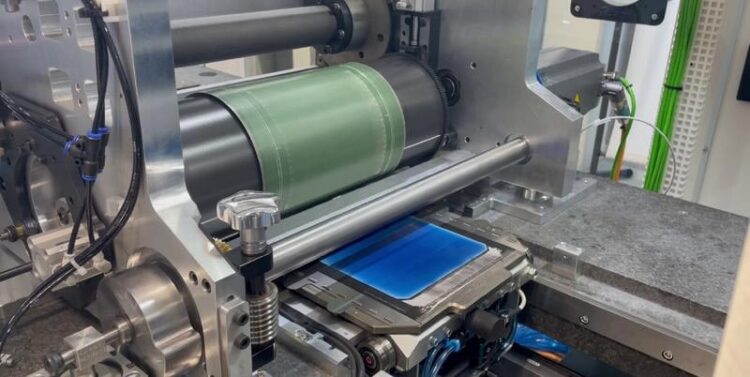Rotary screen printing boosts cycle times

Metallization of a silicon wafer by means of rotary screen printing in a demonstrator.
Fraunhofer ISE
Currently, flatbed screen printing is the standard process used for the metallization of silicon solar cells and many other electronic components. Using a new production machine developed jointly with ASYS Automatisierungssysteme GmbH, researchers at the Fraunhofer Institute for Solar Energy Systems ISE have now managed to increase the print throughput by a factor of 1.5. In order to achieve this, rotation screen printing and flexographic printing were used for the first time. With the new machine, the research team achieved a cycle time of just 0.6 seconds per solar cell.
The new process can also be used for functional printing in the areas of hydrogen technology, sensor technology and power electronics.
Visitors to the LOPEC 2022 (March 23–24, 2022, International Congress Center Munich) can learn about the concept at the research institute’s booth (FO.10).
Dr. Florian Clement, Head of Department Production Technology – Structuring and Metallization, Printing Technology at Fraunhofer ISE, explains the reason for the interest in this research: “Metallization by screen printing is currently limited to a throughput of approximately 0.9 seconds per solar cell and line. This makes the printing step a bottleneck in the production process of silicon solar cells as well as in the printing process of single components in many other industries.”
In order to step up the throughput in the metallization process, a project consortium under the joint leadership of ASYS Automatisierungssysteme GmbH and Fraunhofer ISE has developed a demonstrator machine for the high-throughput metallization of silicon solar cells and other electronic components. In a proof-of-concept demonstration, it was shown that the print process throughput can be increased by a factor of 1.5. “The machine has the technical potential to double the throughput compared to screen printing machines,” explains Dr. Andreas Lorenz, project manager at Fraunhofer ISE.
The new machine features a newly developed high-throughput transport system, in which the components for printing are transported on autonomous shuttles at high speed and with precision through rotary printing units produced by Gallus Ferd. Rüesch AG, a Swiss machine engineering company which is part of Heidelberger Druckmaschinen AG. Finest structures can be printed directly on the components. Depending on the specific requirements, a flexographic printing or a rotary screen printing unit can be used for the printing process. The modular system design also facilitates other printing and coating processes such as multi-nozzle dispensing or gravure printing.
The potential applications of the new system extend far beyond the metallization of silicon solar cells. While the overwhelming majority of printing and coating systems on the market operate on the roll-to-roll printing principle and are thus limited to web-based substrates, this system addresses the high-throughput printing of unit-load components such as solar cells, printed circuit boards, chip cards and a multitude of other components.
The process and machine were developed in the Rock-Star and Rock-IT research projects and funded by the Federal Ministry of Education and Research (BMBF) and the Federal Ministry for Economic Affairs and Climate Action (BMWK, formerly BMWi).
Wissenschaftliche Ansprechpartner:
Dr. Florian Clement: florian.clement@ise.fraunhofer.de
Media Contact
All latest news from the category: Machine Engineering
Machine engineering is one of Germany’s key industries. The importance of this segment has led to the creation of new university degree programs in fields such as production and logistics, process engineering, vehicle/automotive engineering, production engineering and aerospace engineering among others.
innovations-report offers informative reports and articles covering technologies such as automation, motion, power train, energy, conveyor, plastics, lightweight construction, logistics/warehousing, measurement systems, machine tools and control engineering.
Newest articles

High-energy-density aqueous battery based on halogen multi-electron transfer
Traditional non-aqueous lithium-ion batteries have a high energy density, but their safety is compromised due to the flammable organic electrolytes they utilize. Aqueous batteries use water as the solvent for…

First-ever combined heart pump and pig kidney transplant
…gives new hope to patient with terminal illness. Surgeons at NYU Langone Health performed the first-ever combined mechanical heart pump and gene-edited pig kidney transplant surgery in a 54-year-old woman…

Biophysics: Testing how well biomarkers work
LMU researchers have developed a method to determine how reliably target proteins can be labeled using super-resolution fluorescence microscopy. Modern microscopy techniques make it possible to examine the inner workings…





















